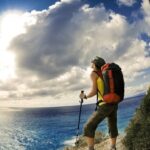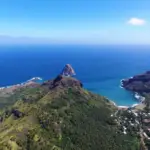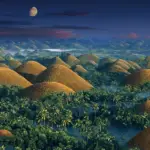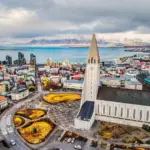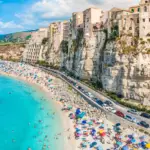
Puna Argentina is a stunning region of the Argentine desert, known for its exotic beauty and breathtaking landscapes. With diverse ecosystems, from snow-capped mountains to salt flats, Puna Argentina is an unmissable destination for nature and adventure lovers.
In this definitive guide, we'll introduce you to everything you need to know to explore Puna Argentina. From how to get there to where to stay, the best activities and tourist attractions, important tips and precautions, and much more.
Main Conclusions:
- The region of Puna Argentina is famous for its exotic beauty and breathtaking landscapes.
- In this guide, we will present a complete guide to explore the area, including transportation, accommodation, activities and helpful tips.
- Puna Argentina offers a variety of unique ecosystems, from snow-capped mountains to salt flats.
- Visitors can enjoy activities such as tours, trails, sightseeing and gastronomic experiences.
- It is important to be aware of issues such as safety, weather and altitude when visiting Puna Argentina.

What is Puna Argentina?
Puna Argentina is a region located in the north of Argentina, in the heart of the Argentine desert. It is a vast, arid expanse that spans several provinces, including Salta, Jujuy, and Catamarca. The region is characterized by its vast mountain range, plateaus, salt flats, and salt lakes, as well as its rich history and indigenous culture.
The Puna region of Argentina is considered one of the highest in the world, with altitudes ranging from 3,500 to 4,800 meters above sea level. Because of this, the region has unique climatic and landscape characteristics, making it a tourist destination popular with travelers looking for adventure and nature.

The unique beauty of Puna Argentina
Puna Argentina is a stunning area of the Argentine desert with stunning landscapes and diverse ecosystems. Its unique beauty has attracted visitors from all over the world.
The breathtaking landscapes of Puna Argentina include the Andes Mountains, the Salinas Grandes salt flats, and the region's impressive volcanoes. The region is also home to unique flora and fauna, including vicuñas, Andean flamingos, and llamas.
There are many must-see sights to visit in Puna Argentina. The Tastil ruins are one of the most important archaeological sites in the region, containing evidence of an ancient civilization that spanned over 200 hectares. Another popular tourist attraction is the Mummy Cemetery, where mummies of pre-Columbian peoples were found in the desert.
For nature lovers, Puna Argentina also offers options like Los Cardones National Park, which boasts a variety of cacti across its 65,000 hectares. Laguna Pintascayo Provincial Park is one of the best birdwatching spots in the region, with over 100 recorded species.
Puna Argentina is a true jewel of the Argentine desert, with its unique beauty and diverse ecosystems. A must-see for anyone who appreciates nature and culture rich in the region.

How to get to Puna Argentina
If you're planning to visit the beautiful Puna Argentina, it's important to know how to get there. The region is difficult to access and located in a remote area of the Argentine desert.
There are several transportation options for getting to Puna Argentina. You can choose between flights, buses, or rental cars. Below, we detail each of these options to help you decide which is best for your trip.
Flights
The most convenient way to reach Puna Argentina is by flight. There are several airports in the region, including Salta International Airport, Jujuy International Airport, and San Salvador de Jujuy Airport. From these airports, you can rent a car or hire a transfer service to reach Puna Argentina. Some airlines, such as Aerolíneas Argentinas and LATAM, offer flights to Salta and Jujuy.
Bus
Another option for reaching Puna Argentina is by bus. Several bus companies operate in the region, including Don Otto, Balut, and Andesmar. Buses depart from Salta and Jujuy and arrive at various cities in the region. However, keep in mind that bus journeys can be slow and uncomfortable due to road conditions.
Rental cars
If you prefer more flexibility and autonomy, you can choose to rent a car to get to Puna Argentina. There are several car rental companies in Salta and Jujuy. However, keep in mind that the roads in the region can be difficult to navigate, so it's recommended that you have experience driving on roads with poor visibility.
Where to Stay in Puna Argentina: Accommodation Options
Puna Argentina offers a variety of accommodation options to suit visitors' needs and preferences. Whether seeking comfort and convenience or preferring simpler, more affordable accommodations, there are options for all tastes and budgets.

Hotels and Inns
For those seeking more comfort and services, there are a variety of hotels and inns in Puna Argentina. Most accommodation options are located in larger cities, such as San Salvador de Jujuy and Salta. There are also some options in smaller towns and cities near the Puna region.
| Name of Hotel/Inn | Location | Average price per night (in reais) |
|---|---|---|
| Hotel Casa de la Adobe | San Salvador de Jujuy | 450 |
| Hostal Antigua Tilcara | Tilcara | 300 |
| Finca Valentina | Cachi | 550 |
Alternative Hosting
In addition to hotels and inns, there are some alternative accommodation options in Puna Argentina. These options are ideal for those seeking closer contact with the local culture and nature.
- Camping: There are several campgrounds throughout the Puna region. Some are located in national parks and offer an experience unique close to nature.
- Family Homes: Some local families offer accommodations in their homes, providing an authentic and intimate experience of Argentine culture.
- Hostels: There are a few hostels in smaller towns in Puna Argentina. They offer affordable options for those looking for simple, uncomplicated accommodation.
Regardless of your choice, it's always important to book in advance, especially during peak season.
What to do in Puna Argentina: Activities in Puna Argentina
When it comes to activities in Puna Argentina, there's something for everyone. This unique region offers a variety of incredible experiences, from leisurely strolls to thrilling nature adventures. Below, we highlight some of the most popular activities in Puna Argentina.

Tours and trails
One of the best ways to explore the beauty of Puna Argentina is to hike one of the many trails available. Trails vary in length and difficulty, so you can choose one that suits your fitness level and interests. Some highlights include:
| Trail Name | Difficulty Level | Distance |
|---|---|---|
| Inca Trail | Moderate | 8 kilometers |
| Salinas Grandes | Easy | 3 km |
| Diamond Lagoon | Difficult | 25 km |
Tourist Attractions
Some of the most popular tourist attractions in Puna Argentina include Salinas Grandes, a stunning salt flat stretching for miles, and Laguna de los Pozuelos, a stunning lake surrounded by mountains. Other attractions include the Llullaillaco Volcano, one of the highest mountains in South America, and the historic town of San Antonio de los Cobres.
Cultural experiences
Puna Argentina also offers unique opportunities to experience local culture. You can visit the region's indigenous villages to learn about the traditional life and history of the local communities. You can also sample local cuisine at local restaurants, sampling dishes like empanadas and locro.
Stargazing
Puna Argentina is famous for its clear skies free of light pollution, making it an ideal spot for stargazing. Many local companies offer nighttime stargazing tours, where you can observe the stars, planets, and constellations in a peaceful and magical setting.
These are just some of the incredible activities you can enjoy in Puna Argentina. No matter what you choose to do, you're sure to have a great time. unforgettable experience in this unique region.
Gastronomy in Puna Argentina
If you're a food lover, the Puna region of Argentina won't disappoint. Try the local cuisine and discover unique flavors and textures!
Some of the most famous dishes in Argentine cuisine originate from the Puna region. The region's quintessential dish is Locro, a hot, thick soup made with beans, corn and meat.
Another delicacy that you cannot miss is the Empanada salteña, a baked pastry stuffed with meat, onions, potatoes, and eggs. It's one of the most popular traditional dishes in Argentina.
In addition, delicious desserts are produced in Puna Argentina, such as Arroz con leche, a dessert made with rice cooked in milk and sugar; and the Alfajores, little cakes filled with dulce de leche that are very popular in the country.
Also, be sure to try the local wines, produced in the nearby wine regions of Cafayate and Salta. These wines are known for their quality and flavor.
Where to eat in Puna Argentina
There are many options for sampling local cuisine in Puna Argentina. Here are some restaurant recommendations:
| Restaurant | Address | Recommended Dish |
|---|---|---|
| La Toldería | Belgrano Avenue 852, Purmamarca | Empanadas salteñas |
| Old Jack | San Martin 66, Salinas Grandes | Locro |
| Pacha Resto Bar | Güemes Avenue 334, Humahuaca | Arroz con leche |
"Argentine cuisine is delicious and varied. In Puna Argentina, the region's typical dishes stand out for their richness and unique flavor. Don't miss the opportunity to try these delicacies while exploring this beautiful region!"
Tips and precautions for visiting Puna Argentina
If you're planning to visit Puna Argentina, it's important to be aware of some tips and precautions to ensure a safe and enjoyable trip. Here are some things to consider before you go:
1. Altitude
Puna Argentina is located at a high altitude, meaning visitors may experience the effects of oxygen deprivation. It's important to take precautions to avoid altitude sickness, such as resting for a day or two before engaging in intense activities, drinking plenty of water, and avoiding alcohol.
2. Climate
The Puna region of Argentina is known for its extreme weather, with very hot days and very cold nights. Be sure to bring appropriate clothing to protect yourself from the strong sun and intense cold.
3. Transportation
It's important to plan your transportation in Puna Argentina in advance. If you plan to rent a car, make sure it's in good condition and fill up whenever possible. If you choose public transport, check schedules in advance and be prepared for delays.
4. Communication
Not all areas of Puna Argentina have reliable cell coverage. Make sure you have a contingency plan to communicate with others in case of an emergency, such as a radio or GPS device.
5. Respect for local culture
Puna Argentina has a rich cultural heritage, and it's important to respect these traditions when visiting the area. Be aware of local cultural practices and be respectful of the customs and traditions of the local people.
6. Security
While Puna Argentina is generally safe for visitors, it's important to take precautions to ensure the safety of yourself and others. Avoid traveling alone at night and always be aware of your surroundings. Check road conditions and carry safety equipment, such as flashlights and first aid kits.

Conclusion
In this last section, we reinforce the key points about the beauty and unique experiences that Puna Argentina has to offer. We hope this guide has provided a comprehensive overview of region and helped inspire you to explore this stunning destination.
With stunning landscapes, a rich local culture, and activities for all tastes, Puna Argentina is a destination that will certainly leave a lasting impression on its visitors. Make the most of your trip by following our tips and exploring all this incredible region has to offer.
Now that you know more about the beauty and attractions of Puna Argentina, don't waste any time and start planning your next trip to this fascinating region of Argentina.
FAQ
What is Puna Argentina?
Puna Argentina is a region located in the Argentine desert, known for its beauty exotic and impressive landscapes.
What is the unique beauty of Puna Argentina?
THE beauty unique of Puna Argentina is in its stunning landscapes, which range from white salt flats and colorful mountains to imposing volcanoes and high-altitude lakes. Furthermore, the region is home to a rich diversity of ecosystems and wildlife.
How to get to Puna Argentina?
There are different transportation options for arriving in Puna ArgentinaYou can choose to fly to nearby cities like Salta or Jujuy, and then use buses or rental cars to reach the region.
Where to stay in Puna Argentina?
In Puna Argentina, you'll find a variety of accommodation options, from hotels and guesthouses to alternative accommodations like farm stays or campsites. The ideal location will depend on your budget and preferences.
What to do in Puna Argentina?
There are many activities to enjoy in Puna Argentina. You can explore the white salt flats of Salinas Grandes, hike to admire the colorful mountains of Hornocal, visit volcanoes like Socompa, or be enchanted by the landscapes of the Pumamarca Desert.
What is the cuisine like in Puna Argentina?
THE gastronomy in Puna Argentina It's rich and delicious. You can try traditional Argentine dishes like empanadas, asado (Argentine barbecue), and locro (meat and vegetable stew). Don't forget to sample the local wines and traditional sweets.
What tips and precautions should I take when visiting Puna Argentina?
When visiting Puna Argentina, it's important to consider some precautions. Due to the high altitude, it's recommended that you acclimatize gradually and be cautious of altitude sickness. It's also essential to bring appropriate clothing and sun protection, as the region can experience extreme temperature fluctuations and high sun exposure.
Lucas Wanderlust has a tireless spirit of adventure, always seeking new travel experiences. Fascinated by the world and the possibility of exploring unknown destinations, he fell in love with the sense of freedom and self-discovery that traveling alone provides. With a backpack on his back and a heart open to the unknown, Lucas embarks on exciting journeys, where each destination becomes a unique chapter in his life story. He gives himself body and soul to the magic of solo travel, inspiring others to follow in his footsteps and discover themselves through adventure.


